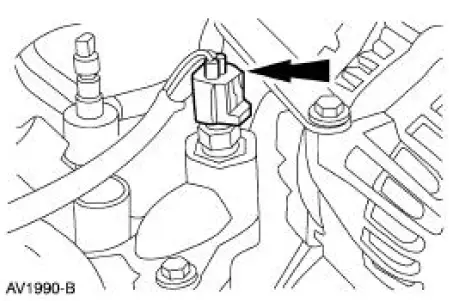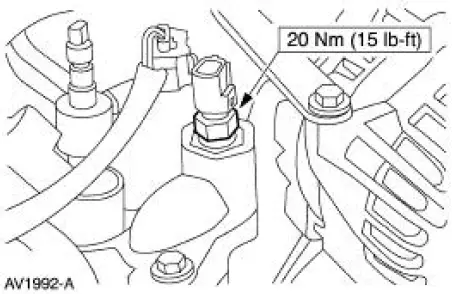Ford Mustang (1999-2004) Service Manual: Engine Coolant Temperature (ECT) Sensor - 4.6L (2V)
Removal
1. Disconnect the battery ground cable. For additional information, refer to Section.
2. Partially drain the cooling system. For additional information, refer to Section.
3. Disconnect the engine coolant temperature (ECT) sensor (12A648) connector.

4. Remove the ECT sensor.

Installation
1. To install, reverse the removal procedure.
 Cylinder Head Temperature (CHT) Sensor - 3.8L
Cylinder Head Temperature (CHT) Sensor - 3.8L
Removal
1. Disconnect the battery ground cable. For additional information
refer to Section.
2. Disconnect the cylinder head temperature sensor connector.
3. Remove the CHT sensor.
Install ...
 Engine Coolant Temperature (ECT) Sensor - Cobra
Engine Coolant Temperature (ECT) Sensor - Cobra
Material
Item
Specification
Pipe Sealant with Teflon
D8AZ-19554-A
WSK-M2G350-A2
Removal and Installation
1. Partially drain the engine cooling system. For additional
informati ...
Other materials:
Module Communications Network
General Specifications
Communications Network
Module Communications Network
...
Air Conditioning (A/C) Pressure Relief Valve - 4.6L
Material
Item
Specification
PAG Refrigerant Compressor
Oil (R-134a Systems)
F7AZ-19589-DA (Motorcraft YN-
12-C)
WSH-M1C231-
B
Removal and Installation
NOTE: Installation of a new suction accumulator is not required when
repairing the ...
Utilizing the mediation or arbitration program
(Canada only)
This pertains to vehicles delivered to authorized Canadian dealers.
In those cases, where you continue to feel that the efforts by Ford of
Canada and the authorized dealer to resolve a factory-related vehicle
service concern have been unsatisfactory, Ford of ...
